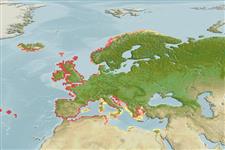Common names from other countries
Environment: milieu / climate zone / depth range / distribution range
Sinh thái học
gần đáy. Temperate
Northeast Atlantic, Black Sea and the Mediterranean Sea. Temperate to subtropical.
Length at first maturity / Bộ gần gũi / Khối lượng (Trọng lượng) / Age
Maturity: Lm ? range ? - ? cm
Known from littoral zone to depths of 20 m. This is a coastal species found in swarms among Zostera weeds close to the shore (Ref. 85342).
Life cycle and mating behavior
Chín muồi sinh dục | Sự tái sinh sản | Đẻ trứng | Các trứng | Sự sinh sản | Ấu trùng
Members of the order Mysida are gonochoric. Mating behavior: Male inserts the penis into the marsupium and releases sperm; eggs are then released from the oviducts into the marsupium where fertilization occurs. Life cycle: Eggs are brooded in the marsupium and later hatch into miniature adults, no postlarva.
Greve, W., F. Reiners, J. Nast and S. Hoffmann. 2004. (Ref. 2988)
IUCN Red List Status (Ref. 130435)
CITES status (Ref. 108899)
Not Evaluated
Not Evaluated
Human uses
| FishSource |
Các công cụ
Thêm thông tin
Age/Size
Sự sinh trưởng
Length-weight
Length-length
Hình thái học
Ấu trùng
Sự phong phú
Các nguồn internet
Estimates based on models
Preferred temperature
(Ref.
115969): 10.7 - 19.3, mean 15.5 (based on 344 cells).
Price category
Unknown.
